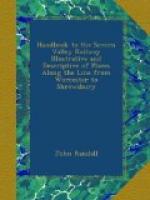[Shrewsbury: 43.jpg]
Close by is a highly ornamental timber gateway, erected in 1620, leading to the Council House, the temporary residence, during feudal times, of the Lords President of the Marches. Continuing along this street, we pass the Raven Hotel, recently rebuilt at a cost of nearly 20,000 pounds. It was here George Farquhar wrote his comedy of the “Recruiting Officer,” which he dedicated to “All friends round the Wrekin.” Descending Pride Hill, the eye rests upon a number of rare old specimens of domestic architecture, which, like those in High Street and others, were the homes of the ancient burghers; mansions here and there of more pretension are also to be seen, mingling an air of antiquity with one of comfort. The town is rich in specimens of ecclesiastical architecture, and possesses some very handsome churches. Of the four whose towers and spires are seen within the circle of the Severn, St. Mary’s is the most interesting. Its site is 100 feet above the river, and its tall and graceful spire is a landmark seen for many miles. The lower portion of the tower, the nave, transepts, and doorway, are of the 12th century, whilst other portions are of the 15th and 16th. The interior, with its clustered columns, decorated capitals, moulded arches, and its oak-panelled ceiling, ornamented with foliage, has a fine effect; added to which, the exquisitely-sculptured pulpit, given in memory of a former minister, and the still more recently erected screen, in memory of another, with numerous mural monuments, in stone and marble, are of peculiar interest. The windows are of stained glass, some being very ancient, and most of them elaborately and beautifully painted, and highly deserving of attention.




